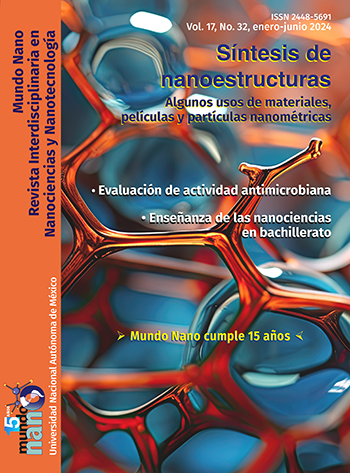Efecto de la temperatura en la formación de nanoestructuras luminiscentes en el KBr:Eu2+
Conteúdo do artigo principal
Resumo
Se presenta el estudio del efecto de la temperatura en la formación de nanoestructuras luminiscentes (NsL) en el monocristal de KBr:Eu2+. Las muestras se almacenaron durante 16 semanas a 100 y 200 °C para formar la fase de Suzuki (FS) y fase dihaluro (FD), respectivamente, la concentración de impurezas en ambos casos fue ~380 ppm. La formación de nanoestructuras fue estudiada por espectroscopía óptica (EO) y las imágenes fueron obtenidas por microscopía de fuerza atómica (AFM). Los espectros de absorción y emisión reportan cambios importantes en 10 Dq para la FS a 11365.2 cm–1, con pico de misión a 433 nm y para la FD 10 Dq a 5319.3 cm–1 con dos picos de emisión a 428.5 y 450.7 nm, característicos de la fase dihaluro. Las imágenes observadas por AFM muestran que las NsL para la FS van desde 40 a 435 nm de diámetro con alturas de 2 a 120 nm, en contraste con la FD donde hay dispersión de tamaños es desde 20 nm hasta de 500 nm de diámetro, pero con alturas limitadas en el intervalo de 1 a 7 nm. Estos resultados comprueban suposiciones teóricas que, efectivamente, la FD es de tipo laminar, los resultados obtenidos están de acuerdo con la literatura reportada.
Downloads
Detalhes do artigo

Mundo Nano. Revista Interdisciplinaria en Nanociencias y Nanotecnología, editada por la Universidad Nacional Autónoma de México, se distribuye bajo una Licencia Creative Commons Atribución-NoComercial 4.0 Internacional.
Basada en una obra en http://www.mundonano.unam.mx.
Referências
Aguilar M., Rubio, O., López F. et al. (1982). Optical absorption and fluorescence investigation of the precipitate phases of Eu2+ in KBr single crystals. Solid State Communications, 44(2): 141-144. DOI: https://doi.org/10.1016/0038-1098(82)90417-3
Bannon, N. M., Corish J. y Jacobs, P. W. M. (1985). A theoretical study of the formation and aggregation of vacancy-impurity dipoles in divalently doped alkali halide crystals. Philosophical Magazine A, 51(6): 797-814. https://doi.org/10.1080/01418618508237588. DOI: https://doi.org/10.1080/01418618508237588
Cordero-Barboa A. E., Jiménez-García L. F. (2005). Epifluorescence optical microscopy: a sensitive tool for determining the spatial distribution of europium-dihalide precipitates in KCl:KBr:Eu2+ crystals. Philosophical Magazine Letters, 85: 345-357. https://doi.org/10.1080/09500830500229378. DOI: https://doi.org/10.1080/09500830500229378
Cordero-Borboa A. E. y Unda-Angeles R. (2021). Quadruple node of triple junctions of grain boundaries in a Eu2+-doped solid solution of the ions K+, Rb+, Cl− and Br−: an epifluorescence microscopy study using the doping ion as a fluorochrome. Microscopy, dfab047. https://doi.org/10.1093/jmicro/dfab047. DOI: https://doi.org/10.1093/jmicro/dfab047
Delgado Medina, José Nicolás. (2012). Formación de nanoestructuras de europio en matriz de KBr por efecto de la temperatura, tesis de licenciatura, asesorada por E. V. Mejía-Uriarte. Universidad Nacional Autónoma de México, México. https://ru.dgb.unam.mx/handle/DGB_UNAM/TES01000695887.
Farzaneh A. y Reza Abdi M. (2018). CsI nanocrystal doped with Eu2+ ions for radiation detection. Journal of Luminescence, 194: 424-427. https://doi:10.1016/j.jlumin.2017.10.034. DOI: https://doi.org/10.1016/j.jlumin.2017.10.034
Hernández J., Cory W. K. y Rubio O. (1980). Optical investigation of divalent europium in the alkali chlorides and bromides. Journal Chemistry of Physics. 72:198-205. https://doi.org/10.1063/1.438875. DOI: https://doi.org/10.1063/1.438875
Horcas, I., Fernández, R., Gómez-Rodríguez, J., Colchero, J., Gómez-Herrero, J. y Baro, A. (2007). WSXM: A software for scanning probe microscopy and a tool for nanotechnology. Review Scientific Instrument, 78: 013705-1-013705-8. https://doi.org/10.1063/1.2432410. DOI: https://doi.org/10.1063/1.2432410
Kim, H. J., Rooh G., Khan A., Park, H., Kim, S. (2018). Scintillation performance of the TlSr2I5 (Eu2+) single crystal. Optical Materials, 82: 7-10. https://doi.org/10.1016/j.optmat.2018.05.036. DOI: https://doi.org/10.1016/j.optmat.2018.05.036
López, F. J., Murrieta, H., Hernández, J. Rubio, O. (1980). Optical absorption and luminescence investigations of the precipitated phases of Eu2+ in NaCl and KCl single crystals. Journal Physics Rev B, 22: 6428-6439. https://doi.org/10.1103/PhysRevB.22.6428. DOI: https://doi.org/10.1103/PhysRevB.22.6428
Mejía-Uriarte, E. V., Castañeda-Guzmán, R., Villagrán-Muniz, M., Camarillo, E., Hernández, J., Murrieta, H. y Navarrete, M. (2003). Studies of the thermal dissolution process of the Suzuki phase of the Eu2+ ion in KBr single crystals by analysis of the photoacoustic signals. Journal Physics: Condensed Matter 15(40): 6889-6898. https://doi.org/10.1088/0953-8984/15/40/024. DOI: https://doi.org/10.1088/0953-8984/15/40/024
Mejía-Uriarte, E. V., Navarrete, M, Villagrán-Muniz, M, Camarillo, E., Hernández, J. y Murrieta, H. (2005a). Dissolution studies about the aggregate-precipitate of the divalent europium ions into KBr crystals by photoacoustic technique. Journal de Physique IV, 125: 277-280. https://doi.org/10.1051/jp4:2005125066. DOI: https://doi.org/10.1051/jp4:2005125066
Mejía-Uriarte, E. V., Camarillo, E., Hernández, J., Navarrete, M., Villagrán-Muniz, M. y Murrieta, H. (2005b). Thermal dissolution of Eu2+ Suzuki phase nanostructures in KBr crystals monitored by pulsed photoacoustic and photoluminescence techniques. Optical Materials, 27(7): 1316-1319. https://doi.org/10.1016/J.OPTMAT. DOI: https://doi.org/10.1016/j.optmat.2004.11.030
Mejía-Uriarte, E. V., Bañuelos, J., Kolokoltsev, O. et al. (2009a). Influence of europium nanostructure size on the emission of KBr:Eu2+. Solid State Communications, 149: 445-447. https://doi.org/10.1016/J.SSC. DOI: https://doi.org/10.1016/j.ssc.2008.12.042
Mejía-Uriarte, E. V., Bañuelos, J., Kolokoltsev, O. et al. (2009b). Self-assembled rings EuBr2 nanostructures. Materials Letters, 63(5): 554-556. https://doi.org/10.1016/J.MATLET.2008.11.039. DOI: https://doi.org/10.1016/j.matlet.2008.11.039
Mejía-Uriarte, E.V., Kolokoltsev, O., Navarrete, M., et al. (2015). Study of NaCl:Mn2+ nanostructures in the Suzuki phase by optical spectroscopy and atomic force microscopy. Journal of Luminescence, 160: 293-298. https://doi.org/10.1016/J.JLUMIN.2014.12.015. DOI: https://doi.org/10.1016/j.jlumin.2014.12.015
Muñoz Santiuste, J. E. y García Solé, J. (1988). Precipitation-induced quenching of Eu2+ luminescence in NaCl:EuCl2. Physical Review B, 38, 10874. DOI: https://doi.org/10.1103/PhysRevB.38.10874
Stand, L., Zhuravleva, M. y Melcher, H. C. L. (2015). Crystal growth and scintillation properties of potassium strontium bromide. Optical Materials, 46: 59-63. https://doi.org/10.1016/j.optmat.2015.04.002. DOI: https://doi.org/10.1016/j.optmat.2015.04.002
Soundara Pandian, L. et al. (2021). TlSr2I5:Eu2+ - A new high-density scintillator for gamma-ray detection. Nuclear Instruments and Methods in Physics Research Section A: Accelerators, Spectrometers, Detectors and Associated Equipment, 988: 164876. https://doi.org/10.1016/j.nima.2020.164876. DOI: https://doi.org/10.1016/j.nima.2020.164876
Suzuki, K. (1961). X-ray studies on precipitation of metastable centers in mixed crystals NaCl-CdCl2. Journal of the Physical Society of Japan, 6(1): 67-78. https://doi.org/10.1143/JPSJ.16.67. DOI: https://doi.org/10.1143/JPSJ.16.67
Zaldo, C., Orozco, E., Mendoza, A. y Rubio, O. (1985). Eu precipitation in plastically deformed alkali halides. Journal of Physics D: Applied Physics, 18(2): 247-258. https://doi.org/10.1088/0022-3727/18/2/012. DOI: https://doi.org/10.1088/0022-3727/18/2/012





